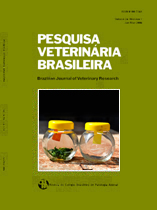 |
|
|
|
Year 2012 - Volume 32, Number 3
|

|
Mortality of zebu cattle by hypothermia in Mato Grosso do Sul, Brazil, 32(3):204-210
|
ABSTRACT.- Santos B.S., Pinto A.P., Aniz A.C.M., Almeida A.P.M.G., Franco G.L, Guimarães E.B. & Lemos R.A.A. 2012. [Mortality of zebu cattle by hypothermia in Mato Grosso do Sul, Brazil.] Mortalidade de bovinos zebuínos por hipotermia em Mato Grosso do Sul. Pesquisa Veterinária Brasileira 32(3):204-210. Laboratório de Anatomia Patológica, Faculdade de Medicina Veterinária e Zootecnia, Universidade Federal de Mato Grosso do Sul, Campo Grande, MS 79070-900, Brazil. E-mail: lap.famez@ufms.br
This study describes the periodic mortality of cattle due to hypothermia after thermal inversion in Mato Grosso do Sul, Brazil. Sixteen outbreaks, reported to the Laboratory of Animal Pathology FAMEZ/UFMS, occurred from August 2000 to July 2010 in 13 municipalities of the state. The diagnosis of hypothermia was based on the occurrence of deaths after a sudden decrease in temperature accompanied by rain and wind in several farms simultaneously, on clinical signs and on the absence of significant macroscopic and microscopic lesions. In all outbreaks was a sudden fall of temperature up to29°C at intervals of one to four days together with rain and wind. Most deaths occurred in places with scarce pasture and lack of natural or artificial shelters. The affected cattle were lean, with low body score, and in most cases on the morning following sudden fall in temperature, they were found dead in the corners of wintering and near the fences. Cattle of different ages were affected. Clinical signs were characterized by apparent blindness, incoordination, dysmetria, weakness, sternal recumbency, paddling, opisthotonus, muscle tremors, difficulty in breathing and death. In 30 necropsied animals the main macroscopic findings were subcutaneous, cavity and pulmonary edema. Histologically in some cases neuronal eosinophilia was observed. Hypothermia is an important cause of mortality when cattle, not acclimated, with poor nutritional status, low availability and quality of pasture, and lack of natural shelter, are subjected to climate change with sudden fall in temperature combined with high winds and rain. |
| |
|
|
| |
|
 |